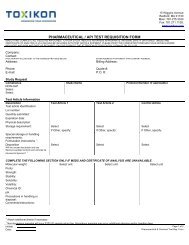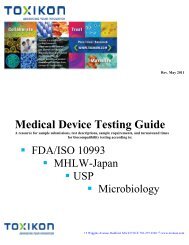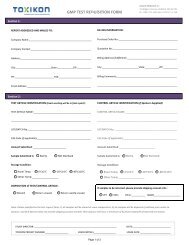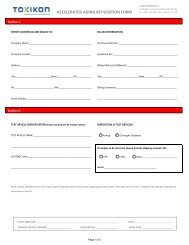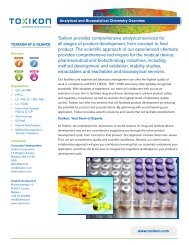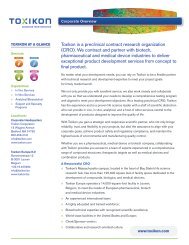Biocompatibility Safety Assessment of Medical Devices ... - Toxikon
Biocompatibility Safety Assessment of Medical Devices ... - Toxikon
Biocompatibility Safety Assessment of Medical Devices ... - Toxikon
Create successful ePaper yourself
Turn your PDF publications into a flip-book with our unique Google optimized e-Paper software.
ISO 10993-3 MHLW 2003<br />
Extraction vehicles:<br />
A physiological medium is used<br />
and, where appropriate, a solvent<br />
(e.g. dimethylsulfoxide)<br />
Extraction:<br />
Extract test material and test the<br />
extract or dissolve material in<br />
solvent and conduct test. The<br />
conditions <strong>of</strong> extraction should<br />
maximize the amount <strong>of</strong> extractable<br />
substances, as well as subject the<br />
test device or material to the<br />
extreme conditions it may be<br />
exposed to, without causing<br />
significant degradation. Extraction<br />
ratio is dependent on thickness <strong>of</strong><br />
test material.<br />
Recommends methanol and<br />
acetone as extracting vehicles<br />
Extract at room temperature at<br />
a ratio <strong>of</strong> 10:1 (solvent<br />
material) and obtain residue (at<br />
least 0.1–0.5% [weight <strong>of</strong><br />
residue/weight <strong>of</strong> test<br />
material]), redissolve in<br />
appropriate solvent and test<br />
residue.<br />
If sufficient residue is<br />
unobtainable, extract test<br />
material (in ethanol, acetone, or<br />
DMSO at 10 g <strong>of</strong> test material<br />
per 20 ml for the Arnes<br />
mutagenicity assay, and in cell<br />
culture medium at 120 cm 3 or 4<br />
g/20 ml for the chromosomal<br />
aberration assay), at 37°C for<br />
48 hours and test extract. The<br />
Ames mutagenicity assay is<br />
conducted with a volume <strong>of</strong><br />
200 µl per plate.<br />
Table VIII. Differences in genotoxicity testing procedures required by ISO 10993-3 and<br />
the MHLW guidelines.<br />
Differences in the procedures required by ISO 10993 and the MHLW for genotoxicity<br />
testing are illustrated in Table VIII.<br />
IMPLANTATION<br />
The local effects <strong>of</strong> an implantable device or a material on tissue are assessed by<br />
implantation procedures that introduce the material or device, or a representative portion,<br />
into tissue. The implanted tissue region is allowed to heal, then explanted and examined<br />
for macroscopic and microscopic tissue responses. The evaluation <strong>of</strong> the effects <strong>of</strong> the<br />
implantation test is by assessment <strong>of</strong> several macroscopic and microscopic parameters,<br />
including fibrosis, degeneration; presence <strong>of</strong> phagocytic cells, necrosis, fatty infiltration,<br />
and foreign debris.<br />
13



